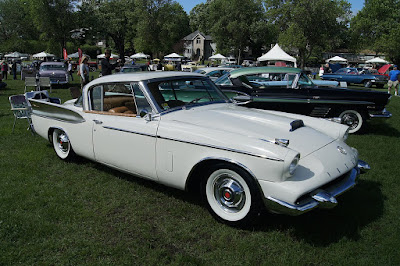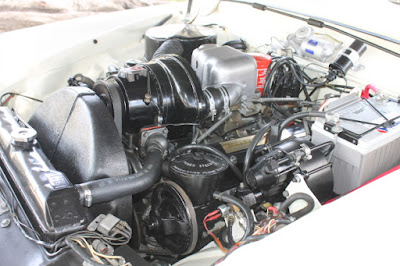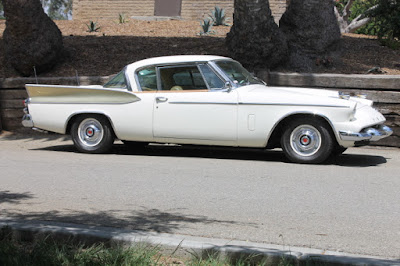Speed DEMON We will continue the discussion about fast cars made in Russia while under the regime of the Soviet Union.
 |
| 1951
GAZ 'Torpedo' uses an four-cylinder 2.4-liter engine that delivers 105
hp of power at 4,000 rpm and could be make the machine run up to the top
speed of 191 kph. (Picture from: http://bit.ly/2MkEisr) |

In the second part of articles, We invites You to take a look at the most unique interesting conceptual and experimental cars were aver developed by Soviet engineers and designers during the 1950s and early the 1960s.
6. 1954 GAZ TR 'Arrow'
And
the Russian experimental car was constructed in 1954 which received
designation of GAZ SG-3 and the nicknamed GAZ TR 'Arrow'. The car had a
tear-shaped aerodynamic body, to be exact the bezramny single fuselage
sheathed by thermoprocessed aluminum sheets.
 |
| 1954
GAZ TR 'Arrow' had a tear-shaped aerodynamic body, to be exact the
bezramny single fuselage sheathed by thermoprocessed aluminum sheets. (Picture from: http://bit.ly/3aTfcer) |
It
already had a turbojet that able to make the speed of the experimental
car achieved about 500 kph, but due to the lack of specially purposed
tracks and high speed tires, the maximum speed should not have exceeded
300 kph according to its test program results.
7. 1955 Zvezda-5 and 1957 Zvezda-6
There
are many similarity technical features for the 1955 Zvezda-5 and 1957
Zvezda-6, such as the engine lied under the hood of both racing cars,
there's a two-stroke 250 cc supercharged engine coupled with four speed
manual gearbox plus independent suspensions for each of its legs
. |
| 1955 Zvezda-5 uses a two-stroke 250 cc supercharged engine with 50 hp, so it could be brought the top speed of 200 kph. (Picture from: http://bit.ly/3rDpBkq) |
The
difference lies in the size of the body and the power capacity
generated by the engine alone. The Zvezda-5 is shorter with 3.20 meters
with the weight of 360 kg, and its machine able to spew power of 50 hp
so it could be brought the top speed of 200 kph.
 |
| 1957 Zvezda-6 uses a two-stroke 250 cc supercharged engine with 54 horse power, so no wonder it was capable run up to the top speed of 220 kph. (Picture from: http://bit.ly/3rynvlT) |
While
the Zvezda-6, instead, had a more powerful engine of 54 hp and,
although the higher weight of 420 kg, so no wonder it was capable run up
to the top speed of 220 kph.
8. 1955 Pomogaybo Avangard
The
car made by Ivan Pomogaybo followed a similar path when he built his
Avangard record car at the plant where he worked as a shop manager. The
streamlined body and mid-engine layout were also combined with extensive
use of parts from the Pobeda car. However, Pomogaybo used a 6-cylinder
engine from a 2.5ton GAZ truck. |
| 1951
Avangard had a mid-engine layout, instead of a front-mounted engine, a
platform frame chassis and elongated, streamlined bodies. (Picture from: https://bit.ly/38M22NB) |
Although
the Avangard secured its status as the fastest car in the USSR in the
3-liter class, it was not as fast as the aforementioned cars. The design
was a mid-engined layout with the power unit located behind the
driver’s seat, in front of the rear axle, and connected to the main gear
by a driveshaft. The body was made of sheet steel. |
| 1955 Pomogaybo Avangard used a 6-cylinder engine taken from a 2.5 ton GAZ truck. (Picture from: https://bit.ly/38M22NB) |
The
car was constantly modernized: the wheelbase was lengthened, the body
panels of a modified shape were made of thinner metal, a new completely
overhead-valve cylinder head and a more advanced blade-type supercharger
were installed on the engine, an additional gearbox was integrated into
the main gear and so on. Engine power has been increased to 220 hp. The
Avangard reached its zenith in 1955 with a top speed of 257.6 kph.
9. 1956 Moskvich-G2
This
was a record-breaking racing car designed by I.A. Gladilin and I.I.
Okunev, and built in 1956. The Moskvitch G2 set three Soviet speed
records in long-distance racing.
 |
| 1956 Moskvitch G2 set three Soviet speed records in long-distance racing of the 1950s. (Picture from: http://bit.ly/3pwURzG) |
It
competed in the 1959 USSR Championship and won in the under 2500cc
class. The Moskvitch G2 was no longer used after 1960 and written off in
late 1963. Only two were built , and both were dismantled for spare
parts.
10. 1962 ZIL 112S and ZIL 112RG
One of the most successful Soviet racing cars was the ZIL 112 S which appeared in 1962. Like most sports cars in the Soviet era, the ZIL 112 S used parts from another Soviet-produced cars. For example, its front suspension is taken from the GAZ 21 Volga, although the rear suspension is completely original, as well as disc brakes on all wheels (rear brake is attached to main gear). Meanwhile, the engine and transmission are taken from the ZIL 110. |
| 1962 ZIL 112 S racing cars can run around 260-270 kph in general depending on its engine. (Picture from: http://bit.ly/3oiCQ89) |
Although only two cars ever built, and both cars developed from the ZIS 110, after had slightly redesigned as to be used lighter aluminum components. One unit has a 6 liter V8 engine capable of producing 230 hp, and the other uses a 6.95 liter V8 engine capable of producing 270 hp. The performance of this race car depends on the engine, in general the ZIL 112 S can run around 260-270 kph. And when compared to the previous modified version of the 112, the ZIL 112 S has a shorter wheelbase (2,190 mm) and is more lighter (1,300 kg). |
| 1962 ZIL 112 RG racing car featured with a brand-new, more enclosed body and belly-pan fairing, covering all the mechanicals beneath the car. (Picture from: http://bit.ly/3oiCQ89) |
In a later development, one of the cars was given the name ZIL 112 RG after received a brand-new, more enclosed body and belly-pan fairing, covering all the mechanicals beneath the car. Those car making intended to try to break the Soviet land speed record. Then this car was taken to the Astrakhan region to run on the Baskunchak salt lake. But that year, Baskunchak had a lot of rain (which in fact is almost never seen there) and the ZIL 112 RG only hit 200-230 kph, because the tires couldn't run any faster on such surfaces.😞
Note: This blog can be accessed via your smart phone.











































